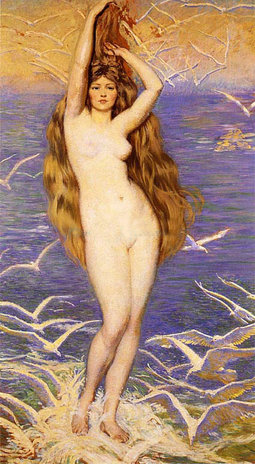SACRED HAVEN COVEN
Aphrodite

Born from the Foam; The Golden One; Far Shining; She of Beautiful Buttocks; The Shape-Shifter; She Who Postpones Old Age; The Dark One; The Black One; The Gravedigger; The Queen ; The Lady of the Sea; The Black Queen
Aphrodite, although now most associated with Greece, is originally a Semitic fertility/war Goddess, like Astarte or Ishtar.
According to Olympian myth, when Uranus, Spirit of the Sky, was castrated, his severed member, dripping with sperm and blood, dropped into the fertile sea. Aphrodite was born of this merger of sea and sky. She came ashore at Cyprus, carried to land on a large scallop shell. Fittingly for a sex Goddess, the Greek word kteis means “vulva” as well as “scallop”.
In another version of her origin, She was considered a daughter of Zeus and Dione, the mother Goddess whose oracle was at Dodona. By the late 5th century BC, certain philosophers had begun to draw a distinction between two separate "Aphrodites" Aphrodite Ourania, the celestial Aphrodite, born from the sea foam after Cronus castrated Uranus, and Aphrodite Pandemos, the common Aphrodite "of all the folk", born from the union of Zeus and Dione. Aphrodite Ourania is associated with spiritual love, and Aphrodite Pandemos with physical love (desire). A representation of Aphrodite Ourania with her foot resting on a tortoise came to be seen as emblematic of discretion in conjugal love.
Although the ancient Greeks adored Aphrodite, they were uncomfortable with the merger of sex, fertility, and war spirit all bundled up in the form of a beautiful woman. In order to incorporate Aphrodite into the Olympic pantheon, the Greeks compartmentalized her, suppressing her warrior attributes. This is made clear in Homer’s Iliad, when she is ordered off the battlefield.
Aphrodite’s main function in Greece became love, romance, sex and protection of mariners. By the end of the Classical Era, many were uncomfortable with her raw sexuality; She was re-envisioned as Aphrodite Urania, Goddess of Heavenly Love.
Aphrodite is always depicted as having no childhood, She was born as a fully grown, beautiful, desirable adult.
Because of Her amazing beauty, Zeus feared that the other Gods would become violent with each other in their rivalry to possess her. To forestall this, he forced Her to marry Hephaestus, the dour, humorless God of smithing. Hephaestus was overjoyed to be married to the Goddess of beauty, and forged Her beautiful jewelry, including the cestus, a girdle that made Her even more irresistible to men.
Her unhappiness with her marriage caused Aphrodite to seek other male companionship, most often Ares, but also sometimes Adonis to whom She was also a surrogate mother. When Adonis was born his mother was turned into a myrtle tree by her jealous husband. Aphrodite found the infant Adonis at the base of the tree and took pity on him. She put him in a box and took him to Hades for Persephone to look after. Adonis grew into a strikingly handsome young man, and when Aphrodite returned to Hades to claim Adonis, Persephone didn't want to give him up. The two Goddesses began such a quarrel, that Zeus was forced to intercede. He decreed that Adonis would spend a third of the year with Aphrodite, a third of the year with Persephone, and a third of the year with whomever he wishes. Adonis, of course, chose Aphrodite.
When petitioning Aphrodite, be sure to fulfill your end of the bargain in a timely fashion. She is not a patient Goddess. If She loves you, She will expect constant gifts and attention. She usually demonstrates Her anger through animal attacks or bad luck in love.
FAVORED PEOPLE: Lovers, practitioners of sacred sex and sex magick, sex workers, those involved with erotica. She is the matron of mariners and sailors.
MANIFESTATIONS: Aphrodite most commonly manifests as a mermaid or a blindingly beautiful woman who shines so bright that she dazzles the eye. Roses bloom beneath Her feet. She likes company and often travels with and entourage of God/desses. She will likely be accompanied by at least one of Her sacred animals, and if there is more than one animal, they will not appear together peaceably. This is a sure sign that Aphrodite is near.
ICONOGRAPHY:
- Early statues portray Her wearing a polos hat and robes pattered with roses or stars.
- Later statues portray Her in various stages of undress.
- She was venerated in the form of a conical stone at a temple dedicated to Aphrodite at Paphos. The stone was celebrated on many Roman coins.
Aphrodite is sometimes depicted a s a black statue; vestiges of her worship may survive in some Black Madonnas. Images of Aphrodite holding her baby son Eros, may have inspired some Madonna and child imagery.
ATTRIBUTES: Scallop and cowrie shells, sea anemone, fishing net; Aphrodite possesses a magick belt that serves as an irresistible love magnet: She is generous and will share this girdle as well as secrets of romance and erotica, via dreams and visualizations.
COLORS: Yellow, gold, copper, black
BIRDS: Dove, sparrow, swallow, swan, goose, partridge
SACRED ANIMALS: Aphrodite is Queen of all Beasts and loves all wildlife, but some are especially sacred to Her: bear, bee, deer, dolphin, goat, leopard, lion, rabbit, toad, turtle, wolf
ELEMENT: Water
METAL: Copper
MOUNTS: Aphrodite rides a goat or a young male deer on land, a dolphin at sea, and a swan or goose in the air. Doves pull her chariot.
NUMBER: 6
PLANET: Venus, the Sun
PLANTS: Apples, pomegranates, poppies, linden trees, myrtle, Star of Bethlehem. All roses are sacred to Aphrodite especially rock roses and dog roses which grew from the tears that She wept for Adonis. The rose carries Aphrodite’s perfume.
TIME: The Summer Solstice; ancient devotees celebrated the day by decorating small toy boats with flower garlands, then sending them out to sea bearing petitions for Aphrodite.
PLACES:
- Aphrodite’s most sacred place is Cyprus. The Rock of Aphrodite, the spot where She supposedly came ashore, stands near Old Paphos on the southwest coast of Cyprus.
- The Ionian island of Cythera; this is the land nearest where her Father’s severed genitals hit the water and thus Her point of conception. Her mortal son Aeneas built Her a temple there.
- Corinth, once Her main sanctuary on the Greek mainland.
- Her Great Temple at Erice, Sicily, is now the home of the Black Madonna of Custonaci.
SHRINES & ALTARS: Aphrodite’s Altars must always be beautiful. Decorate with ocean motifs, flowers, greenery, and representations of Her attributes and sacred creatures. Alternately create a garden in Her honor, which becomes an outdoor shrine or altar.
OFFERINGS: Call Aphrodite with the scent of frankincense and myrrh. Other favorite offerings include perfume, roses, myrtle, honey and wine. Ancient worshippers offered triangle-shaped honey cakes. Commandaria, a Greek dessert wine, was traditionally served at Her festivals.
Sources: www.meteorman.org
Wikipedia
Encyclopedia of Spirits by Judika Illes
1371453
1702908
